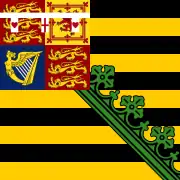Flag of Saxony
Both the civil and state flag of the German state of Saxony feature a bicolour of white over green, similar to the Austrian province of Styria although they are historically not related to each other. The state flag is similar to the civil flag, except it is defaced in the centre with the coat of arms of Saxony. The colours of both flags were officially decided as state colours in 1815.[1] The aristocracy used mostly and in first time the quadrangular and later the rectangular
 | |
| Name | Landesflagge |
|---|---|
| Use | Civil flag |
| Proportion | 3:5 (or 1:2) |
| Adopted | 1920, 1947, 1991 |
| Design | A bicolor of white over green. |
.svg.png.webp) Variant flag of Free State of Saxony | |
| Name | Landesdienstflagge |
| Use | State flag |
| Proportion | 3:5 (or 1:2) |
| Adopted | 1991 |
| Design | The civil flag with the addition of the coat of arms. |
Overview
The civil bicolour flag of white over green was used before World War II, and formally abolished in 1935, under the reforms of the Third Reich. It was readopted 1945 when Saxony became a state again, and abolished 1952 under governing reforms of the German Democratic Republic. When Germany was reunited, Saxony became a state again, and so the flag was finally officially readopted in 1991, having been a much used symbol during the demonstrations in the German Democratic Republic in 1989/90.[2]
Landtag of the Free State of Saxony
Landtag of the Free State of Saxony uses its own flag.
Minority flags
Paragraph 4 of Article 2 of the Constitution of the Free State of Saxony guarantees other flags equality alongside the Saxon state flag.[3]
.png.webp) Flag of Silesians (with eagle)
Flag of Silesians (with eagle)

Gallery
- Previous versions
 First Saxon flag of Old Saxony (700–785)
First Saxon flag of Old Saxony (700–785) Saxon flag by the House of Ascania; associated for the Saxon Ostmark and battleflag for the Saxon Eastern March; crusades around 950
Saxon flag by the House of Ascania; associated for the Saxon Ostmark and battleflag for the Saxon Eastern March; crusades around 950.svg.png.webp) Royal standard of the House of Wettin
Royal standard of the House of Wettin Ducal standard of Saxe-Coburg-Gotha (1826–1920), designed by Queen Victoria
Ducal standard of Saxe-Coburg-Gotha (1826–1920), designed by Queen Victoria.svg.png.webp) Saxe-Altenburg (1602–1672, 1826–1918, 1918–1920)
Saxe-Altenburg (1602–1672, 1826–1918, 1918–1920).svg.png.webp) Saxe-Meiningen flag design during 1826–1918
Saxe-Meiningen flag design during 1826–1918
 Modern Royal standard of the House of Wettin
Modern Royal standard of the House of Wettin Electorate of Saxony (1356–1806)
Electorate of Saxony (1356–1806) The height of Saxony's power: Flag of the Union State of Saxony, Poland and Lithuania (1697–1706; 1709–1763)
The height of Saxony's power: Flag of the Union State of Saxony, Poland and Lithuania (1697–1706; 1709–1763) Without coat of arms (the flag of the Habsburg Monarchy, until 1815)
Without coat of arms (the flag of the Habsburg Monarchy, until 1815) The flag of the Kingdom of Saxony (1815–1918), the Free State of Saxony (Weimar Republic (1918–1925), and reunified Germany (1991 until today)
The flag of the Kingdom of Saxony (1815–1918), the Free State of Saxony (Weimar Republic (1918–1925), and reunified Germany (1991 until today) War flag with cannons, bombs, lances and one Fire Salamander, who can live in, eat and his drunken blood protects from fire (1697–1706; 1709–1763)
War flag with cannons, bombs, lances and one Fire Salamander, who can live in, eat and his drunken blood protects from fire (1697–1706; 1709–1763) The banner of the Margraviate of Meissen for troops or princes (1806–1918)
The banner of the Margraviate of Meissen for troops or princes (1806–1918).svg.png.webp) Duchy of Saxe-Weimar-Eisenach (1809–1920)
Duchy of Saxe-Weimar-Eisenach (1809–1920) Duchy of Saxe-Eisenach (1596–1638; 1640–1644; 1662–1809)
Duchy of Saxe-Eisenach (1596–1638; 1640–1644; 1662–1809).svg.png.webp) Saxe-Coburg and Gotha (1826–1911)
Saxe-Coburg and Gotha (1826–1911).svg.png.webp) Saxe-Coburg and Gotha (1911–1920)
Saxe-Coburg and Gotha (1911–1920) Saxe-Gotha-Altenburg (1680–1826)
Saxe-Gotha-Altenburg (1680–1826).svg.png.webp) Saxe-Hildburghausen (1680–1826)
Saxe-Hildburghausen (1680–1826) Flag of Gau Saxony (1933–1945)
Flag of Gau Saxony (1933–1945)
See also
References
- State Chancellery (1991), Gesetz über das Wappen des Freistaates Sachsen vom 18. November 1991 (Law on the arms of the Free State Saxony of 18 November 1991)
- Siobhán Ryan (2002-03-19), Verwaltungsvorschrift des Sächsischen Staatskanzlei über die Beflaggung der Dienstgebäude im Freistaat Sachsen (Administrative Regulation of the Saxon Prime Minister's Office on the Display of Flags in Official Buildings in the Free State of Saxony) (in German)
- "REVOSax Landesrecht Sachsen - Verfassung". www.revosax.sachsen.de. Retrieved 2020-02-17.
